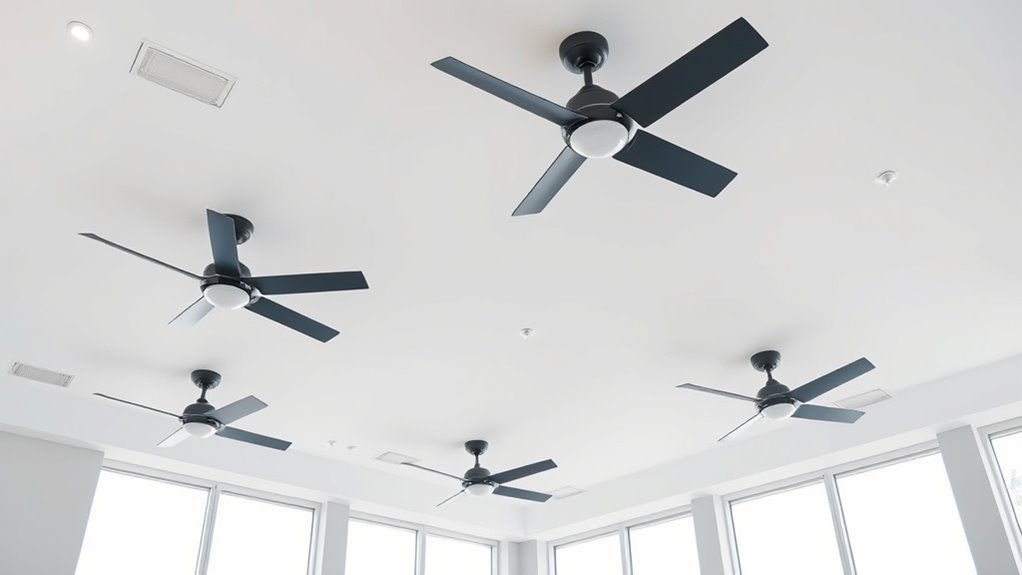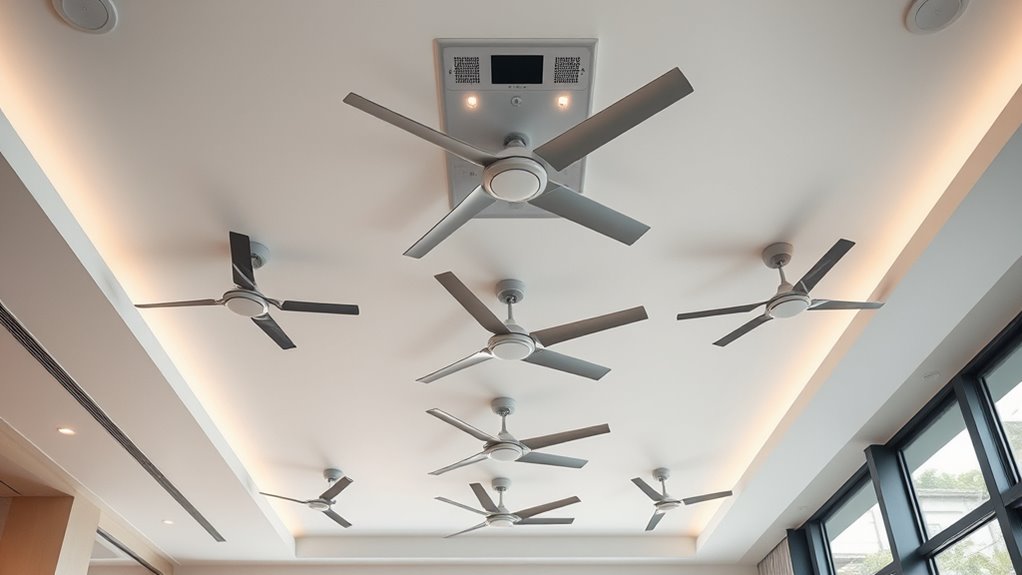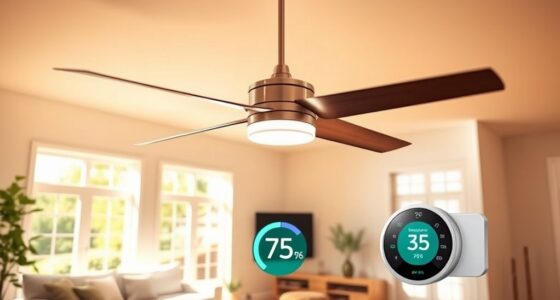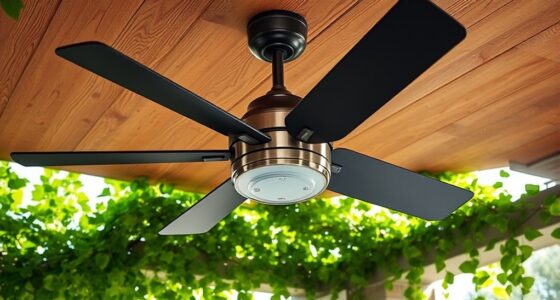To organize smart ceiling fan groups and zones effectively, analyze your building’s layout and occupancy patterns to define logical zones based on rooms or spaces. Use a centralized platform to assign unique names or identifiers to each group, aligning them with physical locations. Implement a hierarchical zoning structure for easier management and automation. Regularly update configurations and make certain your system integrates sensor data for adaptive control, improving energy savings and comfort—more details will reveal how these strategies optimize your setup.
Key Takeaways
- Analyze building layout and occupancy to define logical zones for ceiling fan grouping.
- Use centralized platforms to assign unique names and organize fans by location or function.
- Implement hierarchical zoning (floors, rooms, wings) for streamlined management and targeted control.
- Regularly update groupings and maintain standardized naming to prevent misconfigurations.
- Integrate sensor data and ensure security to enable adaptive automation and efficient energy use.

Effective organization of ceiling fan groups requires a systematic approach to categorization and maintenance. When managing multiple smart ceiling fans within a building or facility, establishing logical groupings enhances control, efficiency, and troubleshooting. You should first analyze the physical layout and usage patterns to define zones that reflect functional or spatial distinctions—such as individual rooms, common areas, or specific HVAC zones. Assigning fans to these zones facilitates targeted control, minimizes latency, and optimizes energy consumption.
Organize ceiling fans into logical zones based on layout and usage for better control and efficiency.
The core of effective grouping involves creating logical clusters based on operational needs and connectivity. Use a centralized smart home or building automation platform that supports grouping features. Within this platform, assign each fan a unique identifier, such as a device ID or name, and then organize them into groups that correspond to their physical location or purpose. For example, all fans in a conference room can be grouped together, enabling synchronized operation for comfort and energy savings. Ensure each group is clearly labeled with descriptive names to prevent confusion during configuration or troubleshooting.
Next, implement a hierarchical zoning structure. Large facilities benefit from multi-tiered organization—starting with broad zones like floors or wings, then subdividing into specific rooms or areas. This layered approach simplifies management and allows for more precise control. When configuring zones, consider factors such as climate control requirements, occupancy patterns, and maintenance schedules. By doing so, you can tailor automation routines and schedules that align with actual usage, reducing unnecessary operation and conserving energy.
Furthermore, maintain an accurate and up-to-date database of all ceiling fans and their group assignments. Regularly review and update the groupings to accommodate renovations, equipment upgrades, or changes in building use. This practice prevents misconfigurations and ensures that control commands reach the correct units. Establish standardized naming conventions and documentation protocols to streamline future modifications and troubleshooting.
In addition, integrate sensor data and automation rules with your groups. For example, if motion sensors detect occupancy, trigger specific fan groups to activate or adjust their speed. Similarly, link temperature sensors to zones, enabling adaptive control based on ambient conditions. This integration maximizes energy efficiency and occupant comfort, while simplifying manual intervention.
A further important consideration is ensuring security of your smart systems, which involves safeguarding control commands and sensor data from cyber threats. Finally, implement monitoring and diagnostic tools to oversee group performance. Use the platform’s analytics to identify irregularities or performance degradation within specific groups. Scheduled maintenance can then be directed precisely, reducing downtime and extending equipment lifespan. In sum, systematic organization of smart ceiling fan groups and zones hinges on clear categorization, hierarchical structuring, accurate documentation, and integration with automation and monitoring systems. This disciplined approach ensures efficient operation, ease of management, and optimized comfort across your entire facility.
Frequently Asked Questions
Can I Include Different Brands of Ceiling Fans in One Group?
Yes, you can include different brands of ceiling fans in one group if they support compatible smart home protocols like Zigbee, Z-Wave, or Wi-Fi. Make certain each fan is integrated with your hub or app that allows cross-brand communication. Confirm that the fans operate on the same frequency and protocol to prevent connectivity issues. Proper configuration and compatibility checks are essential for seamless control across different brands in a single group.
How Do I Change the Default Name of a Fan Group?
You can change the default name of a fan group by accessing your smart home app. First, locate the group in the device list, then tap or select it to open its settings. Look for the “Edit” or “Rename” option, usually represented by a pencil icon. Enter your preferred name, save changes, and your new group name will now display. This process guarantees clear, custom identification for your ceiling fan groups.
Is It Possible to Set Different Schedules for Zones?
Yes, you can set different schedules for zones. Access your smart home app and navigate to the zone settings. Select the specific zone you want to customize, then look for scheduling options. From there, you can create or modify schedules tailored to each zone’s requirements. Guarantee each zone’s schedule is saved individually, allowing distinct operation times, temperatures, or fan speeds, providing precise control over your smart ceiling fans.
Can I Control Fan Groups via Voice Commands?
Yes, you can control fan groups via voice commands if your smart ceiling fans are integrated with a compatible voice assistant like Alexa or Google Assistant. Make certain each group is properly labeled and linked to the voice platform. You can then issue commands such as “Turn on the living room fan group” or “Set the bedroom fan group to 50% speed.” Make sure your voice assistant app is configured correctly for seamless control.
What Should I Do if a Fan Doesn’t Respond to Group Commands?
If a fan doesn’t respond to group commands, first verify its connection to the smart home network. Make certain the fan is properly assigned to the correct group or zone within the app. Restart the fan’s power cycle and re-sync it with the hub or controller. Check for firmware updates and make sure your voice assistant has the necessary permissions. If issues persist, remove and re-add the fan to the group, then test again.
Conclusion
By logically organizing ceiling fan groups and zones, you optimize energy efficiency and comfort. For instance, a commercial office retrofit grouped fans by airflow zones, reducing energy use by 20%. Implementing a structured zoning system guarantees targeted control, minimizing unnecessary operation. This approach streamlines management, enhances user experience, and lowers operational costs. Precise zoning and grouping are essential for maximizing the benefits of a smart ceiling fan system, delivering both efficiency and tailored comfort in any environment.








